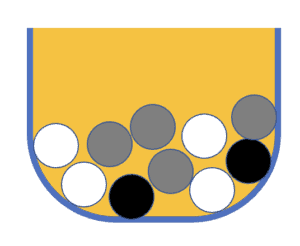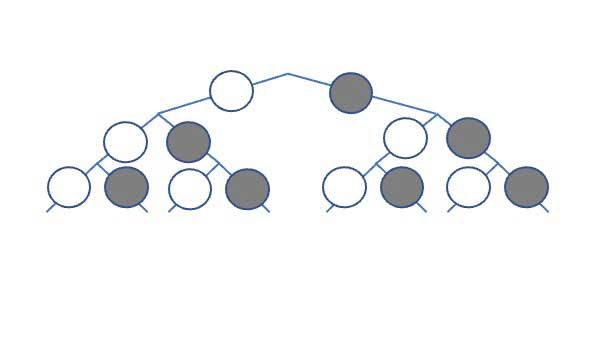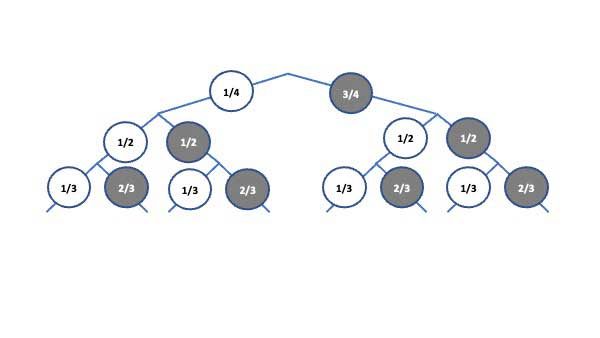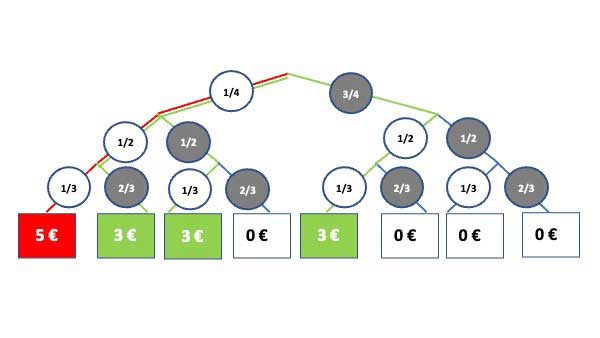Probability calculation tasks 🎲
On this page you will find tasks on probability, i.e. maths tasks for grade 9. These tasks are usually part of the topic of probability in grade 9 or 10. We cover the topics "conditional probability", "multilevel probability", "tree diagrams", "event and event set" and "tasks with wheels of fortune".
How does conditional and multilevel probability work? 🎲 🎱
One speaks of multi-stage probability when several random experiments are carried out in succession. These can be the same. But they can also be different ones. In order to better understand multi-stage random experiments, it is helpful to represent the situation in a tree diagram.
Example: We throw a die three times in a row. This is a very simple multi-stage random experiment.
Conditional probability is when a condition is given in a random experiment. For example, see Task 3. If the condition in the task is that the student is from the middle school. Solve task 3 to understand it better.
Tasks for probability calculation sheet 1
This worksheet could be a class assignment with a time requirement of 45 minutes. Of course, this time only applies to the work on a sheet of paper and not to the online tasks on this page.
Task 1:
One urn contains 4 white, 2 black and 4 grey balls.
Two balls are drawn one after the other with putting back (each ball is put back directly).
- Draw the result tree and give the result set.
- Calculate the probability of drawing a white ball twice in a row
. - Calculate the probability of not drawing a black ball.
Now a ball is drawn under condition B: the drawn ball is not white.
- For each now possible outcome ω, determine the probability P(ω) and PB(ω).
The model picture for task 1:
4 white balls, 2 black balls, 4 grey balls

Task 2:

The illustrated wheels of fortune are turned one after the other.
For a stake of €1, you get the following winnings:
- 3 € with two white sectors
- 5 € with 3 white sectors.
- Model the random event using a result tree.
- Calculate the probability of winning.
- Make a profit and loss account for 1000 trials.
- Can the organiser make a profit with the gambling or do the players win more with a high number of participants?
Task 3:
There are 1000 pupils at the school. 450 in the lower school, 300 in the middle school and 250 in the upper school. In a quiz, 24% of the lower school students, 15% of the
middle school students and 10% of the upper school students take part.
What is the probability that any participating middle school student will win first prize?
What is the probability that a particular participating middle school student will win a newly introduced middle school prize?
Task 4:
A hunter hits a deer with 60 % probability and a hare with 50 % probability when firing a shot. At night he hits both and can only fire one shot each.
- What is the probability that the hunter goes home with at least one killed animal?
Interactive solutions to task sheet 1
Solutions to task 1
Hints for solving this task
- Drawing from an urn with layback means that the probability of drawing a white, black or grey ball remains the same for each move.
- If every colour is possible on every move, the set of possible outcomes is made up of all possible combinations of colours.
- Remember that the sum of the probabilities at each level must add up to 1.
- Remember that the probabilities along a branch are multiplied. The probabilities of individual branches belonging to one event are added together!
Interactive solution - Work through the tasks online here and find out whether you have understood and calculated the task correctly.
The 🌳 diagram:
Complete the diagram by dragging and dropping the missing probabilities until the diagram is complete.
The 🎲 Probabilities
From the correct tree diagram from the previous sub-task, you can read off the probability by looking at all the branches of the tree that fulfil the condition.
What is the probability at the end of each branch of the tree? Draw the probabilities to the right place here as well
You can calculate the probabilities from the tree diagram for all results (possible branches) and enter them here:
The result set Ω
The result set Ω consists of all possible results that are possible after drawing twice.
These are all colour combinations that can occur. Here it is still open whether we distinguish the order or not. Here, all combinations are given with attention to the order, which corresponds to the numbers 1 - 9 in the picture next to it.
Ω = {(white, white), (black, black), (grey, grey),
(white, black), (white, grey), (black, grey),
(black, white), (grey, white), (grey, black)}
The probabilities sought are:
Conditional probabilities
The task: "Now a ball is drawn under condition B: the drawn ball is not white".
Solutions to task 2
Solution notes
We can represent this experiment with a three-level tree diagram. On each level there are two branches at each new end point: white or grey.
Write down the probability at each branch and at the end the probability for the whole path.
Then count up the branches or paths that lead to a profit.
Draw a tree diagram with the probabilities. If you have tried it yourself, you should first unfold the individual solution steps!
The solutions:
The white circles represent the segment that wins, the grey circle represents a loser.

Now you can write the probability for this event in each circle.
In each circle you will now find the probability.

The path that leads to a profit of 5 € is marked red. The paths that lead to a profit of 3 € are marked green.

Note that if you bet €1, each win must be reduced by that amount to see the actual win.
Now you have to calculate the probabilities for the 3 possibilities:
- Red: 4 € real profit
- Green: 2 € real profit
- White: €1 loss

The probability of winning is the sum of the probabilities of winning €5 and €3. This amounts to about 29.2 %.
The profit and loss account:
Now evaluate for yourself whether gambling is worthwhile for the organiser of the game or for the participants.
Also consider in your assessment that the organiser still has additional costs to pay for staff and equipment.
Solutions to Task 3
Hints for solving this task
First, we should analyse how many students from the class level participate. This also gives us the total number of students taking the quiz.
We then use this information to calculate the proportion of participants from the intermediate level.
For task part b) we only have to look at the numbers of the intermediate level.
Solution to part a) and b)
Solutions to task 4
Solution notes
Model this task with a tree diagram. We assume that first one animal is shot at, then the other animal. This is therefore a multi-stage random experiment. It does not matter whether the hare is shot first or the deer first. In the interactive solution, choose the shot at the deer as the first shot.
Now look at the tree diagram and find the paths that fit the task.
Alternatively, we can also write down the cases (probabilities) without a tree diagram.
Tip:
Consider whether the counter-event of the event you are looking for is easier to calculate. If this is the case, first calculate the probability for the counter-event. The result you are looking for is then "P = 1 - counter-event.
Preliminary consideration:
Counter-event:
What is the counter-event to "hit at least once"?
The bill:
Tree diagram:
Now draw the tree diagram with the values for the probabilities!
Move your mouse over the picture or click on it to see the solution.
Click on the picture!
🎲 Probability worksheets
Probability Calculation Tasks - Sheet 1
You can find more worksheets on this topic until the complete construction of this page at the current material page with maths problems from Mathefritz at Maths worksheets at Mathestunde.com .

 Print out task sheet 1 as PDF
Print out task sheet 1 as PDF